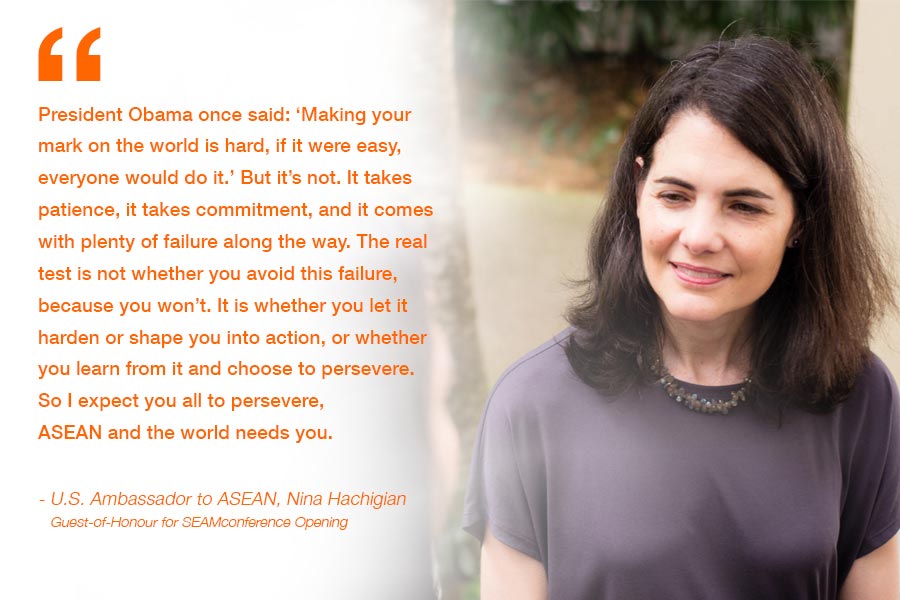SEAMconference 2016: Constructing the ASEAN Identity
Published: 30 June 2016
Students from NUS University Scholars Programme (USP) and Yale University got together recently to organise an international conference for high school students across Southeast Asia. USP Highlights spoke to the conference leaders from both universities - Cassandra Pee (NUS USP) and Luyi Chen (Yale) - to learn all about it.

Please share with us what this project is about.
This is the inaugural Southeast Asian Movement Conference (SEAMconference), held from 27 to 30 May 2016. Jointly organised by the University Scholars Programme (USP) and the Yale Student Southeast Asian Movement (YaleSEAM), this conference provided a platform for youths to come together to think critically and creatively about the region and the sensible way forward.
Specifically, SEAMconference 2016 brought together 100 high school students across Southeast Asia to look at the theme of “Constructing the ASEAN Identity”. We chose this theme because we recognise that regionalism is important in managing new realities as the challenges we face today become increasingly complex, and as the post-Cold War global order of interdependence and openness is questioned. Building an ASEAN Community that celebrates our diversity, and emphasises a commitment to regional unity, is essential.
In executing the conference, we set out to evaluate the ASEAN identity through discussing issues pertaining to education, social inequality, the arts and culture. Understanding a variety of perspectives and personal experiences related to these issues allowed us to negotiate the complexities that will accompany our attempt to forge regional unity. During the four days, we aimed to bring together diverse perspectives on the past, present and future of ASEAN through keynote speeches, panels, field trips, and break-out sessions. Participants heard from a variety of distinguished guests including University Professor Wang Gungwu and U.S. Ambassador to ASEAN, Nina Hachigian, and were led in small groups by experienced and committed facilitators from USP, Tufts, Wellesley and Harvard. We also brought participants on field trips that presented a grounded perspective of policymaking, so that these young students could understand that the needs and aspirations of the community must be considered in policymaking.
The programme also aimed to equip participants with the skills necessary to critically and creatively address the theme of the ASEAN identity: what it is, what it can be, and how we can achieve it. It also sought to create a conducive platform for discourse between participants from diverse backgrounds to share their experiences and opinions. At the end of the conference, each team of participants presented a policy memo with recommendations that responded to the theme of creating an ASEAN identity. The policy memo allowed participants to consolidate and synthesise the ideas and perspectives they were exposed to during the conference period. These policy memos were then critiqued by a distinguished panel of judges who provided valuable feedback and suggestions on issues of feasibility, content relevance and presentation.
What motivated you to take on the project?
While conferences in Singapore that focus on ASEAN as a theme are not lacking, conferences that emphasise Southeast Asians, not just Singaporeans, and youth voices are harder to find. By gathering 100 youths from all over the region, we wanted this conference to be for the Southeast Asian youth. The fact that this conference promised a unique way of discussing ASEAN, valuing diverse voices and lived experiences, made it a worthwhile and valuable project to take on, and hopefully, continue.
What were some challenges you encountered along the way?
This partnership between USP and YaleSEAM was nothing short of challenging. We had to negotiate the 12-hour time difference between Singapore and US as we planned every single detail of this conference together. We learnt how to communicate efficiently and effectively, and the importance of being patient and open-minded. We also had to learn how to trust each other and work synergistically as a team even though we were hardly acquaintances. It’s amazing to see the team come together during the conference proper -- such energy and chemistry!
Another challenge was dealing with uncertainty. We did not know how the participants would take to the programmes we had planned, whether or not organisations we wanted to work with would be responsive, and so on. We had to learn to be flexible, adaptive, and to tailor our expectations accordingly in order to best meet the objectives of the conference.
What is your main takeaway from the conference?
It made us realise that there is a demand for similar conferences from students in the region. Throughout the conference and after, we saw how Southeast Asian youths came together with a passion to want to effect (positive) change in the region. The unparalleled enthusiasm and commitment of our participants to produce ideas and solutions have encouraged us that we had, perhaps, achieved what we set out to do -- to have their voices heard. Knowing that there are many youths in the region with passion but find similar opportunities lacking, we should feel a responsibility to channel our resources to create more opportunities for Southeast Asian youths to learn and work together.

